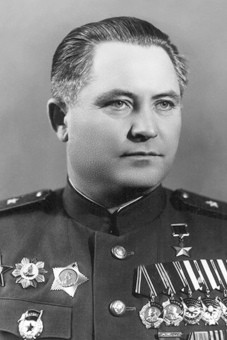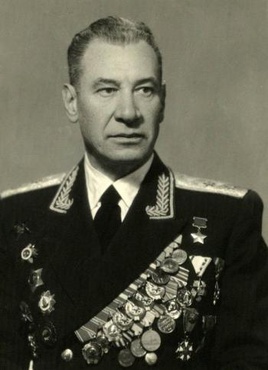The 100th Guards Rifle Division was an elite Red Army airborne infantry division during World War II. The division fought in the Vyborg–Petrozavodsk Offensive and the Vienna Offensive. Postwar, it was designated as an airborne division and disbanded in 1955.

The 18th Army of the Soviet Union's Red Army was formed on 21 June 1941 on the basis of HQ Kharkov Military District and armies of the Kiev Special Military District.

The 7th Guards Army was a field army of the Red Army during World War II and of the Soviet Army during the Cold War.
A rifle corps was a Soviet corps-level military formation during the mid-twentieth century. Rifle corps were made up of a varying number of rifle divisions, although the allocation of three rifle divisions to a rifle corps was common during the latter part of World War II.

The 4th Guards Army was an elite Guards field army of the Soviet Union during World War II and the early postwar era.

The 103rd Separate Guards Airborne Brigade is an airborne brigade of the Belarusian Special Forces. Its predecessor unit was the 103rd Guards Airborne Division, which was a division of the Soviet Airborne Troops. It was established in 1946 and disbanded in 1993, a year after its transfer to the Armed Forces of Belarus. The division was formed from the 103rd Guards Rifle Division, which fought as infantry during the final months of World War II in the Vienna Offensive following its formation in late 1944.
The 9th Guards Army was a field army of the Red Army during World War II, which fought in the Vienna Offensive and the Prague Offensive at the end of the war. The army was formed in January 1945 and included airborne divisions converted into infantry. Postwar, the army headquarters became Soviet airborne headquarters.
The Soviet Airborne Troops formed a number of Airborne Corps during World War II.
The 6th Guards Airborne Division was a Red Army airborne division that fought as infantry during World War II.
The 8th Guards Airborne Division was an airborne division of the Red Army during World War II. On 27 December 1944, it was renamed the 107th Guards Rifle Division. It became the 107th Guards Airborne Division on 7 June 1946, before being disbanded in 1959.
The 105th Guards Airborne Division was an airborne division of the Soviet Airborne Troops.
The 114th Guards Airborne Division was a Red Army airborne division. It was first formed as the 14th Guards Airborne Division. In December 1944, it was converted to the 114th Guards Rifle Division and became an airborne unit again in June 1946.
The 37th Guards Airborne Corps was a Red Army airborne corps. The corps was established as the 37th Guards Rifle Corps on 19 January 1944. In August, it was converted into an airborne corps. On 18 December, it became an infantry corps again. The corps was converted to an airborne corps on 10 June 1946 and disbanded in June 1956.

Pavel Vasilyevich Mironov was a Red Army lieutenant general and Hero of the Soviet Union. Mironov led the 37th Guards Rifle Corps during World War II.
The 38th Guards Airborne Corps was an airborne corps of the Soviet airborne. It was activated during World War II in August 1944 and became a rifle corps in December of that year. The corps fought in the Vienna Offensive and the Prague Offensive during the spring of 1945. After the end of the war, it was converted back into an airborne corps. The corps served at Tula until its 1955 disbandment when the Soviet airborne was reorganized.

Mikhail Fyodorovich Tikhonov was a Soviet Army lieutenant general and Hero of the Soviet Union. Tikhonov fought in the Russian Civil War and the Winter War. He commanded the 39th Guards Rifle Corps during the Vienna Offensive. After the end of World War II, Tikhonov continued his career in the Soviet Armed Forces and was the chief Soviet advisor to the Hungarian People's Army during the Hungarian Revolution of 1956.
The 37th Guards Rechitsa, twice Red Banner, Orders of Suvorov, Kutuzov, and Bogdan Khmelnitsky Rifle Division was an infantry division of the Red Army which fought during World War II.
The 1st Guards Tank Division was a tank division of the Soviet Army from 1945 to 1947, stationed in Neuruppin. It was formed in the spring of 1942 as the 26th Tank Corps. The corps fought in Operation Uranus and became the 1st Guards Tank Corps, being redesignated as a reward for its actions in December 1942. It fought in Operation Gallop, the Third Battle of Kharkov, Operation Kutuzov, Operation Bagration, the East Prussian Offensive, the East Pomeranian Offensive and the Berlin Offensive. During the East Prussian Offensive, the division captured Mława, Działdowo and Płońsk and was awarded the Order of Lenin for its actions. The division had been awarded the honorific "Don" for its actions in Operation Gallop. It also was awarded the Order of the Red Banner and the Order of Suvorov 2nd class.
The 82nd Rifle Corps was a rifle corps of the Red Army and later the Soviet Army.
The 36th Guards Rifle Division was a Guards infantry division of the Red Army during World War II. It was formed from the 9th Airborne Corps in August 1942 as a result of the Soviet need for troops to fight in the Battle of Stalingrad. The division was awarded the honorific Verkhnedneprovsk for its crossing of the Dnieper in September 1943 near that town, later receiving the Order of the Red Banner and the Order of Suvorov, 2nd class, for its actions in the Uman–Botoșani Offensive in March 1944. It fought in the siege of Budapest during late 1944 and early 1945, receiving the Order of Kutuzov, 2nd class, for its actions. In late 1945, it was converted into the 24th Guards Mechanized Division. Stationed in Romania, it was disbanded in early 1947.




